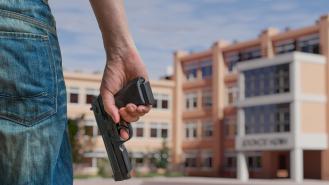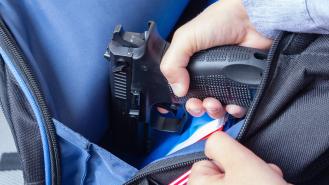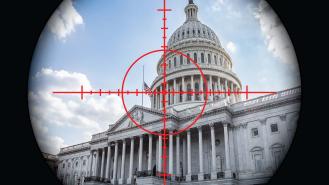
Virginia Tech Massacre: The deadliest school shooting in US history
On 16th April 2007, 23-year-old Seung-Hui Cho killed 32 people and injured another 18 with two semi-automatic pistols at Virginia Tech in Blacksburg, Virginia. It was the worst shooting in US history at the time, only being surpassed by the Pulse Nightclub shooting in Orlando, Florida in 2016, and the Route 91 Harvest Festival shooting in Las Vegas, Nevada in 2017.
Seung-Hui Cho was born in South Korea. He was the second child of Sung-Tae Cho and Hyang Im Cho. As a young boy, he developed whooping cough and was hospitalized with pneumonia. (The Roanoke Times, 31 August 2007 – ‘Details of Seung-Hui Cho’s Life from the Tech Review Panel’s Board’) His family was informed that he had heart problems and, at just three-years-old, doctors performed an invasive procedure. It was theorised that this caused emotional trauma within Cho. In 1992, when he was eight-years-old, the family immigrated from South Korea to the United States because his family had wanted to provide him and his sister with a better education. (Lexington Herald-Leader, 1 September 2007 – ‘Extent of VA. Tech Killer’s Social Disorder Unrealized’) They settled down in Fairfax County.
Cho’s family knew that he was different from a young age. He very rarely spoke, and when he did, it was only ever a couple of words at a time. He refused to look people in the eye and he hated to be touched. His mother would become so frustrated with Cho’s reluctance to speak that she was driven to physically shake him. Cho’s family had tried everything to help him, from counsellors and psychiatrists to art therapy and anti-depressants, yet nothing seemed to work. Before beginning middle school, Cho was diagnosed with a severe social anxiety disorder and later diagnosed with selective mutism.
In 1999, Cho wrote in a school assignment that he wanted to “repeat Columbine” and a psychiatrist prescribed him paroxetine. However, after one year on the antidepressant drug, Cho stopped taking it because he showed signs of improvement. By high school, Cho was enrolled in a special education program because of his selective mutism and social anxiety. Once a week, he attended language therapy and was excused from participating in discussions during class.
Following high school, Cho was accepted at Virginia Tech where he was majoring in English. Once enrolled, he became even more isolated and his behaviour was extremely peculiar. On one occasion, he stabbed a carpet at a party and stabbed the back of his dorm door. He also had a verbal outburst at a teacher who asked him to drop a class because of his violent writing. According to Karan Grewal, who shared a compact suite with Cho at Harper Hall: “He hung out in the common area a lot, working on his laptop or sitting in the rocking chair staring out the window.” (The Roanoke Times, 26 August 2007 – ‘There Was Something Evil Aiding Him’)
During the fall semester of 2005, Cho unravelled even further. He was said to be stalking women and talking about a non-existent girlfriend and brother. He started to call himself “Question Mark” and expressed suicidal thoughts to Andy Koch, who lived in the same dorm suite as him. He was evaluated by a psychiatrist who found that he was mentally ill, a danger to himself and potentially others, and was briefly hospitalized at a psychiatric institution.
Cho never told his family this, and neither did the hospital or the court. “We would have taken him home and made him miss a semester to get this looked at. But we just did not know about anything being wrong,” his family later said.
The school’s counselling centre had tried to treat Cho on several occasions. He had an appointment at Cook Counselling Centre with counsellor Sherry Lynch Conrad in December of 2005. Afterwards, he had two telephone triage sessions and she urged him to return to her in January. Cho never booked an appointment. Cho acknowledged that he was depressed and suffering from anxiety, but denied experiencing homicidal or suicidal thoughts. (The Virginian-Pilot, 22 August 2009 – ‘Single Meeting with a Student Called Typical’)
By the spring semester, Cho had begun planning the shooting. He ordered handguns and purchased ammunition between February and April. On 8th April, he began videotaping his manifesto. For years, he had barely muttered more than one sentence to most people who knew him, but in these videos, he rambled at length. In one, he compared himself to Jesus and spoke about crucifixion. A later panel talked about his manifesto stating: "He portrays a grandiose fantasy of becoming a significant figure through the mass killing.” (USA Today, 31 August 2008 – ‘Panel Details Red Flags Before Va. Tech Tragedy’)
On 16th April 2007, Cho skipped his early morning Bible class at Virginia Tech. He left his dorm before 7am and headed for the West Ambler Johnston dorm. Here, he shot and killed Emily Hilscher and Ryan Clark in her dorm room. He then returned to his dorm, changed his clothing, deleted emails, wiped out his university account, and removed the hard drive from his computer. He then went to the Blacksburg post office and emailed his manifesto to NBC News.
The manifest consisted of both videos and writings. The written manifesto read in part:
“The blood of the Innocents should never be shed, but the wicked we shall spread our wings and strike. We do not want the Weak, the Defenseless, or the Innocent, but the sadistic, the corrupt, and the wicked who prey and rape from the Weak, the Defenseless, and the Innocent. We will seek and demolish them until our last breath. You Lifetakers may have succeeded in raping our souls and shattering our dreams — but mark our words — the vendetta you have witnessed today will reverberate throughout every home and every soul in America and will inspire the Innocent kids that you have fucked to start a war of vendetta. We will raise hell on earth that the world has never witnessed. Millions of deaths and millions of gallons of blood on the streets.”
By this point, the body of Clark had been found. It was erroneously believed that Clark had been killed by Hilscher’s boyfriend after finding him in his girlfriend’s dorm room. Police identified the boyfriend and questioned him, only then discovering that he was not involved. However, it was already too late. Cho had entered Norris Hall and locked the doors behind him with heavy chains so nobody could escape. He walked methodically through the classrooms as he shot at anybody he encountered. Much like he had done so in life, Cho never uttered a word.
In the space of just nine minutes, Cho had fired more than 170 rounds. He had 203 left when police were closing in on him. Instead of surrendering or opening fire on police, Cho placed the barrel of his handgun to his temple and squeezed the trigger, bringing an end to the rampage. He had killed 32 fellow students and teachers.
In the aftermath of the shooting, the community scrambled to find answers for the deadly massacre. Cho’s own family said to the Associated Press that they were feeling “hopeless, helpless and lost,” adding that they “never could have envisioned that he was capable of so much violence.” (The Daily Press, 21 April 2007 – ‘Family of Virginia Tech Killer Feels “Hopeless, Helpless and Lost”’)
To try and find some answers, a review panel was commissioned by Gov. Tim Kane. The report found that university officials had missed a handful of opportunities to intervene as Cho’s mental health deteriorated. However, it also found that university officials were not aware of Cho’s troubled past when he enrolled. The report additionally faulted university officials for not sending out a campus alert between the first two shootings and the following rampage.








